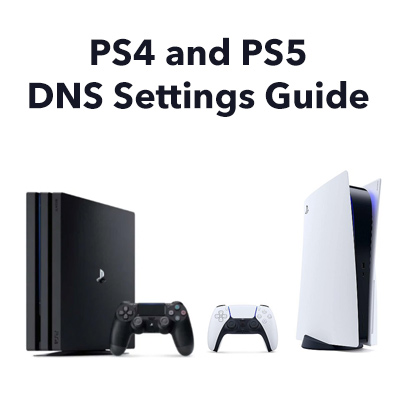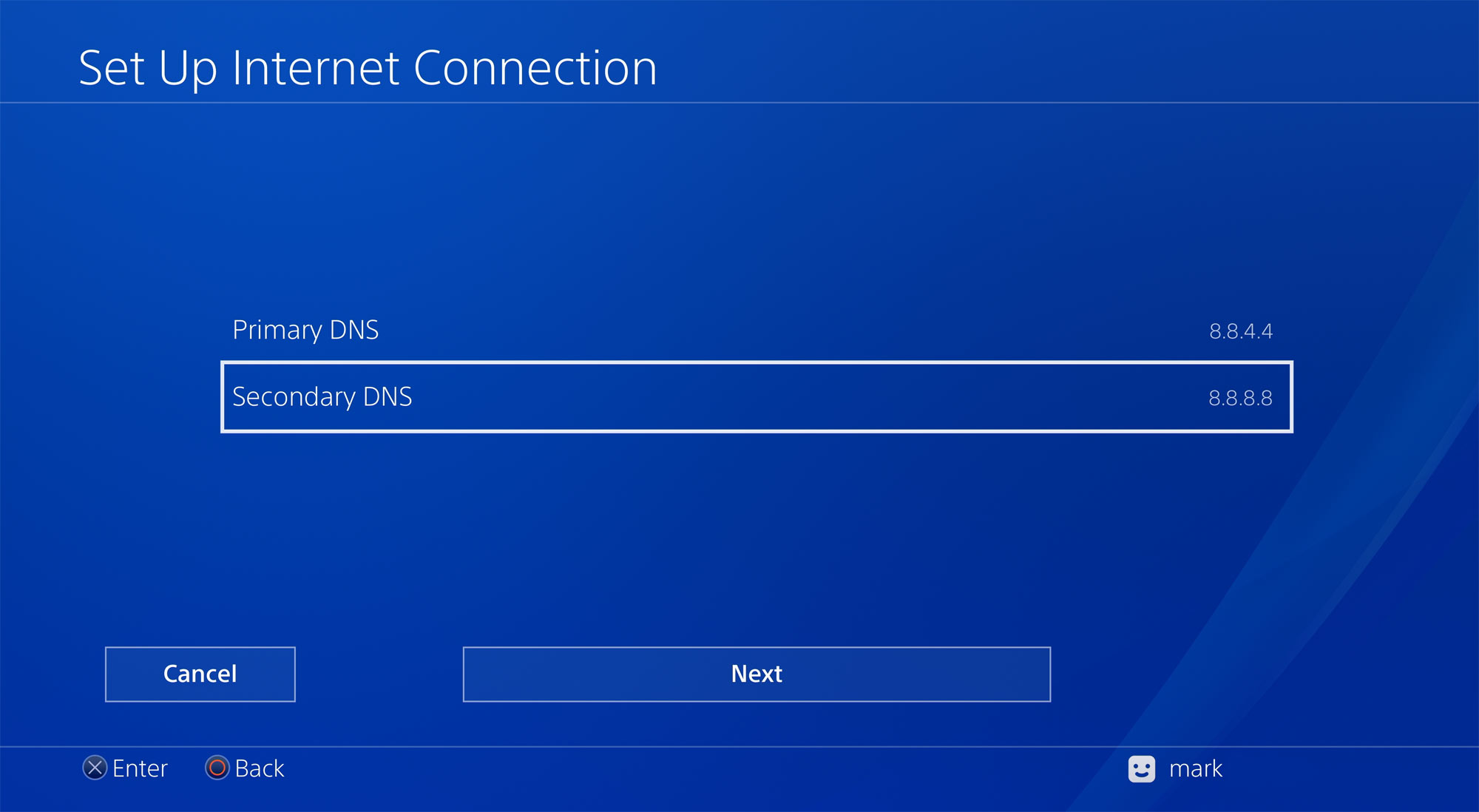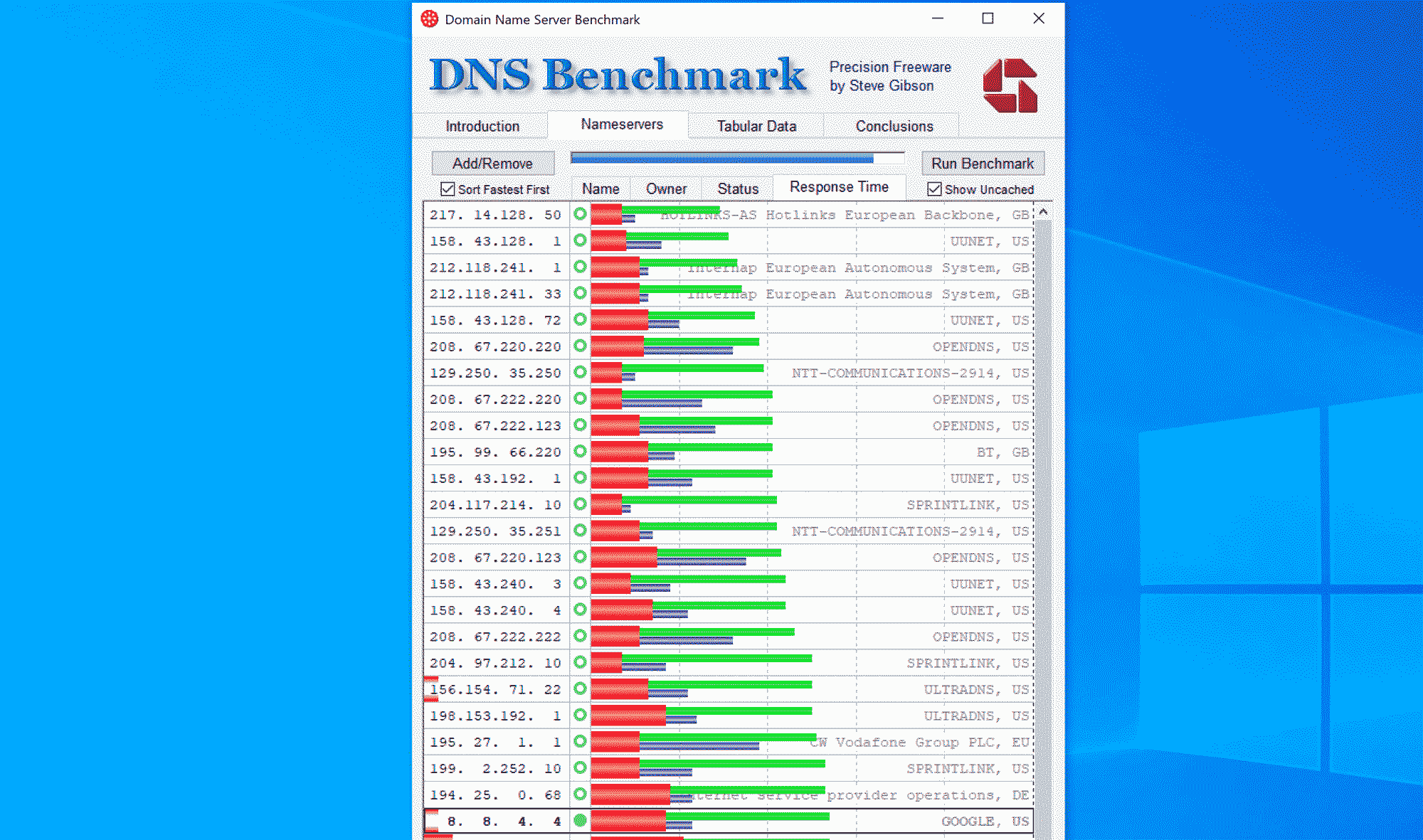 If you want to make the broadband connection to your PS4 or PS5 quicker and more reliable, here’s how to manually change the DNS server settings to the best and fastest DNS servers available in your location. Amazingly, there can be 10,000 or more DNS look-ups taking place on a home network every day and each one creates a delay.
If you want to make the broadband connection to your PS4 or PS5 quicker and more reliable, here’s how to manually change the DNS server settings to the best and fastest DNS servers available in your location. Amazingly, there can be 10,000 or more DNS look-ups taking place on a home network every day and each one creates a delay.
Changing DNS settings on the PS4 and PS5 is really easy to do and can make a huge difference if your broadband provider’s DNS servers are unreliable and/or are geographically located a significant distance away from your location. Be aware that many online guides are out-of-date and some software that has been used to the past is no longer supported. Here in 2024, we’ll give you the best, most up-to-date approach to getting the very best DNS server settings for your PS4 or PS5.
How to enter the DNS server settings in the PS4
Here’s how to enter the best DNS server settings on your PS4. We’ll demonstrate by entering Google’s Public DNS settings (8.8.8.8 and 8.8.4.4), which generally provide good performance and are secure (and free to use). Our guide below allows you to determine if there are even better settings for your location, which you can enter in the same way.

PS4 settings for an Ethernet (LAN) connection
If you are currently using Wi-Fi to connect your PS4 to your router, we strongly advising using an Ethernet cable connection instead as it will be more reliable, faster and have lower average latency and reduced ping spikes. If your Ethernet cable is connected:
Go to Settings and move down the menu to select Network.
Then select the second option Set Up Internet Connection.
Select the option Use a LAN Cable.
Next, rather than clicking on the default Easy option, select Custom.
Assuming that your router is set up to assign IP addresses automatically, select Automatic.
You have the option of setting your own IP address using the Manual option.
For DHCP Host Name, select Do Not Specify.
Then, importantly, select Manual (and not Automatic) for DNS Settings.
Next, you enter your chosen Primary DNS and Secondary DNS settings.
If you want to use Google’s Public DNS settings, enter 8.8.8.8 and 8.8.4.4 (or use your preferred settings).
For MTU Settings, select Automatic.
For Proxy Server, select Do Not Use.
That’s it. Your Internet settings are updated and you are ready to go!
PS4 settings for a Wi-Fi connection
If you use Wi-Fi (and we cannot convinced you of the major performance benefits of using an Ethernet cable instead), then this is how to set the DNS settings with a Wi-Fi set-up.
Go to Settings and move down the menu to select Network.
Then select the second option Set Up Internet Connection.
Select the option Use Wi-Fi.
Next, rather than clicking on the default Easy option, select Custom.
After your PS4 has scanned local Wi-Fi networks, select your Wi-Fi network from the list.
Assuming that your router is set up to assign IP addresses automatically, select Automatic.
You have the option of setting your own IP address using the Manual option.
For DHCP Host Name, select Do Not Specify.
Then, importantly, select Manual (and not Automatic) for DNS Settings.
Next, you enter your chosen Primary DNS and Secondary DNS settings.
If you want to use Google’s Public DNS settings, enter 8.8.8.8 and 8.8.4.4 (or use your preferred settings).
For MTU Settings, select Automatic.
For Proxy Server, select Do Not Use.
That’s it. Your Internet settings are updated and you are ready to go!
How to enter the DNS settings in the PS5
Now we will show you how to enter DNS settings on your PS5. Again, we’ll demonstrate by entering Google’s Public DNS settings (8.8.8.8 and 8.8.4.4), which generally provide good performance and are secure (and free to use). However, there may well be better DNS servers for your particular location. Our guide below allows you to determine if there are even better settings for your location, which you can enter in the same way.
PS5 settings for an Ethernet LAN connection
From the PS5 home screen, click on Settings. Then, select Network. Next, select Set Up Internet Connection.
Of the two options, select Use a LAN Cable.
When presented with the question ‘How do you want to set up the Internet connection?’, select Custom.
Assuming that your router is set up to assign IP addresses automatically, select Automatic. You have the option of setting your own IP address using the Manual option.
For DHCP Host Name, select Do Not Specify.
Then, importantly, select Manual (and not Automatic) for DNS Settings.
We come to the step where you can enter the DNS settings for both the Primary DNS and Secondary DNS. Make sure you enter addresses for both as the Secondary DNS settings will be used if the first DNS server is not working. If you use Google DNS servers, you will enter 8.8.8.8 and 8.8.4.4, but we strongly recommend that you determine the best settings for your location as described later in the page.
Once the numbers are safely entered, you can quickly move through to the final (non-DNS-related) settings by selecting Next. You can select Automatic for MTU Settings and Do Not Use for Proxy Server. You will get the message ‘Internet settings updated’ and you are ready to go with your improved DNS settings.
PS5 settings for a Wi-Fi connection
If you want to use a Wi-Fi connection for your PS5 (and we very strongly recommend using Ethernet cable to get better speeds and lower latency to substantially improve your gaming experience), then do the following.
From the PS5 home screen, click on Settings. Then, select Network. Next, select Set Up Internet Connection.
Of the two options, select Use Wi-Fi.
Next, rather than clicking on the default Easy option, select Custom.
After your PS5 has scanned local Wi-Fi networks, select your Wi-Fi network from the list.
Assuming that your router is set up to assign IP addresses automatically, select Automatic.
You have the option of setting your own IP address using the Manual option.
For DHCP Host Name, select Do Not Specify.
Then, importantly, select Manual (and not Automatic) for DNS Settings.
Next, you enter your chosen Primary DNS and Secondary DNS settings.
If you want to use Google’s Public DNS settings, enter 8.8.8.8 and 8.8.4.4 (or use your preferred settings).
For MTU Settings, select Automatic.
For Proxy Server, select Do Not Use.
That’s it. Your PS5 is ready to go!
How to find the best DNS servers for your PS4 and PS5
There are three approaches, in order of ease, to determine the best DNS servers to use:
- just pick two from our list of Public DNS servers below. DNS providers such as Google have gained a reputation for reliability and speed, and often outperform the DNS servers of broadband providers
- measure the ping to a range of Public DNS servers and pick two with the lowest pings (i.e. which should indicate that they are close to you)
- use software called DNS Benchmark, to comprehensively measure and test a broad range of Public DNS servers to identify the best for your location. Unfortunately, DNS Benchmark does not work with macOS. A program called Namebench, which did work with Macs, has not been developed since 2010 and does not work with macOS Catalina.
Approach 1: Just pick from our list of Public DNS servers
The simplest approach is to pick two servers from our list of Public DNS servers below:
| Provider | DNS Servers |
|---|---|
| 8.8.4.4 8.8.8.8 |
|
| Cloudflare | 1.1.1.1 1.0.0.1 |
| OpenDNS | 208.67.222.222 208.67.220.222 |
| Quad9 | 9.9.9.9 149.112.112.112 |
| Level3 | 4.2.2.1 4.2.2.2 4.2.2.3 4.2.2.4 4.2.2.5 4.2.2.6 |
| Sprintlink | 204.117.214.10 199.2.252.10 |
| NTT | 129.250.35.250 129.250.35.251 |
| Comodo Secure | 8.26.56.26 8.20.247.20 |
| Verisign | 64.6.64.6 64.6.65.6 |
Table: Public DNS Servers
Approach 2: Measure ping to find the DNS servers with the lowest ping
It is advantageous to use a DNS server that is geographically close to you, to minimise:
- the delay waiting for your DNS requests to arrive at the DNS server
- the delay waiting for the response sent by the DNS server to arrive back.
Therefore, rather than just randomly pick DNS servers, you could measure the ping (e.g. using a computer or mobile phone application) for all (or some) of the Public DNS servers on our list above. Here are the results we got:
| IP address of DNS server | Average ping (ms) | Minimum ping (ms) | Maximum ping (ms) |
|---|---|---|---|
| 4.2.2.2 | 6.8 | 7.2 | 7.5 |
| 129.250.35.250 | 7.0 | 6.6 | 7.6 |
| 4.2.2.1 | 7.2 | 6.8 | 8.2 |
| 4.2.2.5 | 7.2 | 6.8 | 7.8 |
| 4.2.2.6 | 7.2 | 6.8 | 7.4 |
| 9.9.9.9 | 7.2 | 6.9 | 7.8 |
| 4.2.2.3 | 7.2 | 7.0 | 7.5 |
| 4.2.2.4 | 7.2 | 7.0 | 8.4 |
| 204.117.214.10 | 7.4 | 7.0 | 7.8 |
| 129.250.35.251 | 7.8 | 7.4 | 8.4 |
| 199.2.252.10 | 8.0 | 7.6 | 9.0 |
| 8.26.56.26 | 8.6 | 8.2 | 9.5 |
| 149.112.112.112 | 11.1 | 10.8 | 11.4 |
| 8.8.4.4 | 11.6 | 11.4 | 12.0 |
| 8.8.8.8 | 11.6 | 11.4 | 12.4 |
| 208.67.222.222 | 11.7 | 11.4 | 12.0 |
| 208.67.220.222 | 11.7 | 11.4 | 12.7 |
| 8.20.247.20 | 12.4 | 12.1 | 12.8 |
| 64.6.65.6 | 12.9 | 11.9 | 17.6 |
| 1.1.1.1 | 14.9 | 14.5 | 15.4 |
| 1.0.0.1 | 15.4 | 15.0 | 16.2 |
| 64.6.64.6 | 17.3 | 15.8 | 22.2 |
Table: Ping measurements for DNS servers
In our case, there was a substantial difference (about 10.5 ms) between the best and worst average ping time. We were also interested to find out that the ping to Google’s DNS servers (which are used by many broadband users to maximise performance) could be improved upon at our particular location. This shows the importance of determining the best DNS servers to use at your specific location as there is not one best setting for everyone.
One site online incorrectly advises PS4 owners to enter DNS settings and then to run an online speed test to determine which DNS servers are best. This approach will not work. All a speed test will give you is a speed test measurement from the speed test server itself, and any ping value provided will be for the speed test server itself.
Please note that while ping measurements are useful to to pick DNS servers that minimise transmission delays, they do not tell you about any processing delays that take place on the server itself when it performs a DNS look-up. This is why the DNS Benchmark program, below, can be very useful.
Approach 3: Download and run the DNS Benchmark program (Windows users)
We recommend that Windows users download a very useful (and free) utility called DNS Benchmark, which can be downloaded here:
DNS Benchmark from the Gibson Research Corporation website
GRC’s DNS Benchmark performs a detailed analysis and comparison of the operational performance and reliability of up to 200 DNS servers. By performing DNS look-ups, the program calculates the total delays to your location.
We totally agree with GRC’s comments about the program when it states:
“You might see someone talking about how fast some specific DNS nameservers are for them, but unless you share their location, there’s absolutely no guarantee that the same nameservers would perform as well for you. ONLY by benchmarking DNS resolvers from your own location, as DNS Benchmark does, can you compare nameserver performance where it matters…right where your computer/PS4 is.”

Given that there may be 10,000 or more DNS look-ups occurring on your home network every single day, reducing the delays from this can really add up to to making a significant difference.
Guides to improve your PS4 and PS5 experience even more
Latency (delay) is the enemy of the online gamer, and home networks can ruin gameplay by increasing average delay (latency) and introducing latency spikes. Minimising latency can give you a competitive gaming advantage. Two major causes of latency issues for PS4 and PS5 owners are:
- the use and (improper set-up) of Wi-Fi
- bufferbloat.
The great news is that you can do something about these. Firstly, we strongly recommend that you connect your PS4 or PS5 to your router by Ethernet cable. While it can be a pain installing cables, you’ll get the benefits every time you use your PS4 or PS5, and you can buy thin and flat Ethernet cables that can be hidden under carpet at very affordable prices.
Typically, Wi-Fi adds 3-7 ms (milliseconds) to the average latency of a broadband connection, whereas the added latency with an Ethernet connection is significantly below 1ms. Worse for gamers, Wi-Fi often causes sporadic latency ‘spikes’, which can reach 50 ms or more. By using an Ethernet cable, you’ll immediately improve average latency to your gaming server by 3-7 ms and eliminate those annoying, and potentially game-ruining, latency spikes. Even those using expensive, so-called ‘gaming routers’ are not immune.
If you insist on using Wi-Fi, please read our Wi-Fi Optimisation Guide to get the very best performance possible from Wi-Fi. We strongly recommend placing a Wi-Fi Access Point near to your games console.
Bufferbloat is an increasing problem due in major part to the increasing use of streamed TV and video services such as Netflix, Amazon Prime and Disney Plus. Bufferbloat can wreak havoc with online gaming by creating latency spikes of 200 ms or more. As described in our How to Fix Bufferbloat guide, it is possible to fix bufferbloat easily by using a router that incorporates Smart Queue Management.
Other pages you may be interested in:
Increase Broadband Speed Guide | Blog | DNS Settings For UK ISPs | DNS Settings For US ISPs | Online Speed Tests – the Best and Worse and How to Use Them
